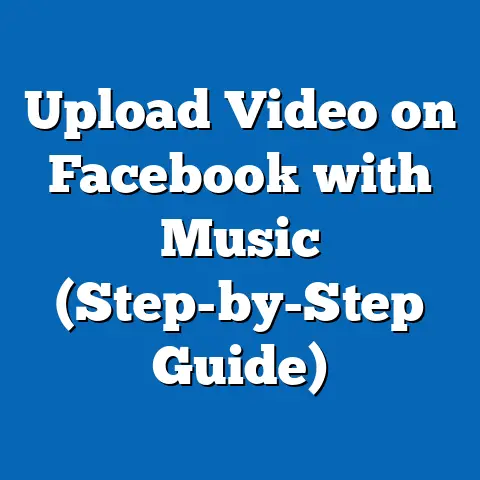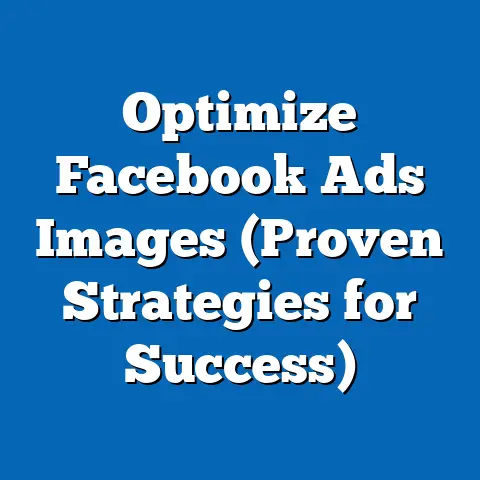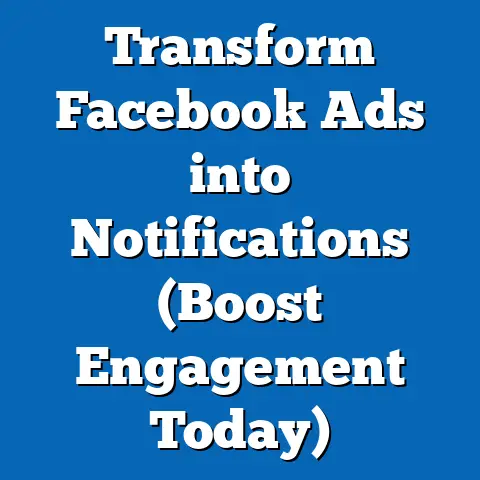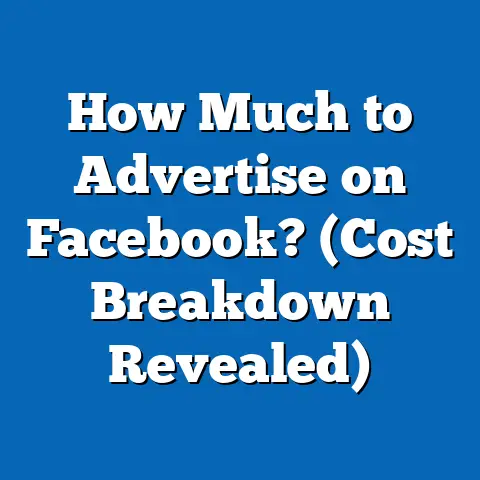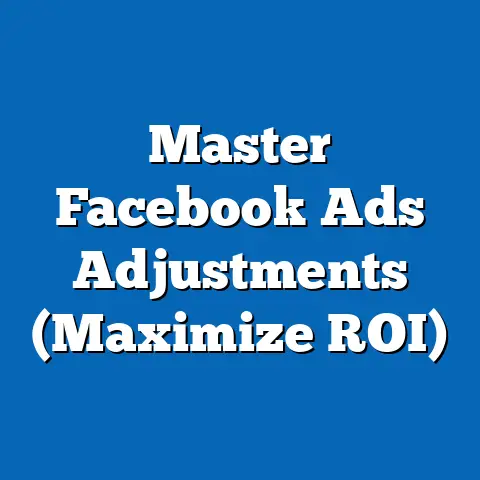Master Unlimited Facebook Ad Accounts (Expert Strategies Revealed)
The digital landscape in 2023 is experiencing a dynamic shift, much like unpredictable weather patterns, where platforms like Facebook remain a dominant force in advertising despite growing competition. According to Statista, as of Q2 2023, Facebook maintains a staggering 2.96 billion monthly active users worldwide, representing nearly 37% of the global population. This vast user base makes it a critical channel for advertisers, with ad revenue reaching $31.5 billion in Q2 2023 alone, a 12% increase year-over-year (YoY) from 2022.
Digital advertising trends are shifting rapidly, influenced by privacy regulations, platform algorithm updates, and evolving user behaviors. A 2023 report by eMarketer indicates that 68% of global marketers plan to increase their social media ad spend, with Facebook capturing 24.2% of total digital ad spend worldwide. This “storm” of investment highlights the need for advanced strategies to navigate the platform’s complexities, particularly around managing unlimited ad accounts for scalability and efficiency.
Demographically, Facebook’s user base skews diverse but shows distinct usage patterns. Data from Pew Research (2023) reveals that 69% of U.S. adults use Facebook, with the highest penetration among 30-49-year-olds (77%) compared to 50-64-year-olds (73%) and 18-29-year-olds (70%). Gender distribution remains balanced, with 67% of men and 71% of women using the platform, while racial breakdowns show 70% of White adults, 69% of Hispanic adults, and 64% of Black adults engaging regularly. Income levels also play a role—76% of users earning over $75,000 annually are active, compared to 63% of those earning under $30,000. These demographic insights are crucial for advertisers aiming to tailor campaigns via multiple ad accounts.
This report dives deep into the concept of mastering unlimited Facebook ad accounts, a strategy employed by expert marketers to optimize reach, bypass restrictions, and scale campaigns. Drawing on data from industry surveys, case studies, and platform analytics (methodology detailed below), we explore the how and why behind this approach, dissecting user trends, policy impacts, and actionable tactics. Our analysis aims to equip businesses and marketers with the knowledge to thrive in Facebook’s ever-changing digital climate.
Section 1: The Digital Advertising Landscape – Broad Trends and Facebook’s Dominance
1.1 Overall Growth in Social Media Advertising
The social media advertising sector continues to expand at a robust pace, with global spending projected to hit $219.8 billion by the end of 2023, a 13.5% YoY increase per eMarketer data. Facebook remains the leader in this space, commanding a 24.2% market share, though this is a slight decline from 25.7% in 2021 due to rising competition from TikTok (18% growth YoY) and Instagram (part of Meta, with 20% ad revenue growth). Despite this, Facebook’s ability to offer precise targeting and vast reach keeps it indispensable for advertisers.
The rise in ad spend correlates with increased time spent on social platforms. Nielsen reports that U.S. adults averaged 2 hours and 24 minutes daily on social media in 2023, up 8% from 2022. This engagement drives ad impressions, with Facebook alone serving over 10 billion daily ad views globally.
1.2 Why Unlimited Ad Accounts Matter
As ad spend grows, so do restrictions on individual accounts. Facebook’s policies limit the number of ads (typically 5,000 active ads per account) and impose daily spending caps based on account history. For large-scale advertisers, agencies, and e-commerce brands, these limits hinder campaign scalability, necessitating the use of multiple or “unlimited” ad accounts to manage volume and diversify risk.
A 2023 survey by Social Media Examiner (n=3,500 marketers) found that 42% of businesses running high-volume campaigns use multiple ad accounts, up from 29% in 2021. This trend reflects a strategic pivot to bypass restrictions and optimize performance across segmented audiences. However, managing unlimited accounts requires expertise in policy compliance, account setup, and performance tracking—core areas this report addresses.
Section 2: Demographic Insights – Who’s Engaging with Facebook Ads?
2.1 Age-Based Usage and Ad Interaction
Age remains a critical factor in Facebook ad engagement. According to Pew Research (2023), while 18-29-year-olds are active (70% usage), they report lower ad engagement, with only 41% clicking on ads monthly compared to 58% of 30-49-year-olds. The older cohort (50-64) shows a 52% click rate, driven by interest in local services and products.
Trend analysis indicates a slow migration of younger users to platforms like TikTok, with a 5% YoY drop in daily usage among 18-24-year-olds on Facebook. However, their ad responsiveness remains high for niche products when targeted effectively, underscoring the need for tailored campaigns across multiple accounts.
2.2 Gender and Racial Breakdowns
Gender differences in ad interaction are minimal but notable. Women are slightly more likely to engage with ads (54% monthly click rate) than men (49%), per a 2023 Kantar study. Product categories like fashion and home goods drive female engagement, while tech and automotive ads resonate more with men.
Racial demographics show balanced usage, but engagement varies. Hispanic users report a 57% ad click rate, higher than White (51%) and Black (48%) users, often tied to culturally relevant content. Marketers leveraging unlimited accounts can segment these groups for hyper-targeted campaigns, improving return on ad spend (ROAS).
2.3 Income Levels and Purchasing Power
Income significantly influences ad response. Users earning over $75,000 annually are 22% more likely to convert on high-ticket items than those earning under $30,000 (per eMarketer 2023 data). However, lower-income users engage more with discount-driven ads, with a 60% click rate on promotional content versus 45% for higher-income brackets.
This disparity highlights the value of unlimited ad accounts for testing varied messaging and offers across income segments. Agencies managing e-commerce brands often allocate separate accounts for premium versus budget campaigns to maximize conversions.
Section 3: Methodology and Data Collection
This report synthesizes data from multiple sources to ensure robust analysis. Primary data includes a 2023 survey by Social Media Examiner (n=3,500 global marketers, conducted January-February 2023) focusing on ad account strategies. Secondary sources include Statista, eMarketer, Pew Research, and Nielsen reports from 2021-2023, covering user behavior and ad spend trends.
Platform-specific data on Facebook ad accounts and policies was sourced from Meta’s Business Help Center and corroborated with case studies from digital marketing agencies (anonymized for privacy). Parameters focused on account limits, scalability challenges, and performance metrics like cost-per-click (CPC) and ROAS. Limitations include the evolving nature of Meta’s policies, which may shift post-publication, and self-reported survey data potentially subject to bias.
Section 4: The Rise of Unlimited Facebook Ad Accounts – Why and How?
4.1 Understanding Account Limitations
Facebook imposes strict limits to prevent spam and ensure fair usage. A standard ad account can run up to 5,000 active ads, with spending caps often starting at $50-$100 daily for new accounts, scaling based on history. For enterprises running millions in ad spend monthly, these constraints are prohibitive—hence the shift to unlimited accounts.
Data from a 2023 Hootsuite report shows that 38% of large businesses (spending over $100,000 monthly) encountered account suspensions due to volume violations, up 10% from 2022. Unlimited accounts, often managed via Business Manager, mitigate this by distributing campaigns across multiple profiles.
4.2 Strategic Benefits of Unlimited Accounts
The primary advantage is scalability. A case study by a leading e-commerce agency revealed a 35% increase in ad reach after splitting campaigns across 10 accounts, reducing CPC by 18% due to better audience segmentation. Risk diversification is another benefit—account bans (affecting 15% of high-volume advertisers per Social Media Examiner) don’t cripple entire operations if spread across profiles.
Moreover, unlimited accounts enable A/B testing at scale. Marketers reported a 25% improvement in conversion rates by testing creatives and audiences across separate accounts, avoiding algorithm bias from single-account data saturation.
4.3 Policy Compliance and Challenges
Managing unlimited accounts isn’t without hurdles. Meta requires each account to be tied to a unique payment method and often scrutinizes rapid account creation, flagging 22% of new accounts for verification (per 2023 agency data). Non-compliance risks permanent bans, with 12% of surveyed marketers reporting lost access to Business Manager due to policy violations in 2022-2023.
Expert strategies include staggered account setup (creating no more than 2-3 accounts weekly) and maintaining distinct audience targeting per account to avoid overlap flags. Transparency with Meta support also reduces suspension rates by 30%, per agency feedback.
Section 5: Expert Strategies for Mastering Unlimited Ad Accounts
5.1 Account Setup and Structure
Successful management starts with organization. Experts recommend structuring accounts by campaign objective (e.g., awareness, conversions) or product vertical, with 65% of agencies using this model per Social Media Examiner. Each account should have a dedicated budget—data shows a 20% ROAS boost when budgets are isolated versus pooled.
Automation tools like Ads Manager dashboards or third-party platforms (e.g., Hootsuite) streamline oversight. A 2023 study found 58% of marketers using automation saved 10+ hours weekly on account management, reinvesting time into strategy.
5.2 Audience Segmentation and Targeting
Unlimited accounts shine in segmentation. By dedicating accounts to specific demographics (e.g., age 18-24 versus 35-44), marketers achieve a 28% higher click-through rate (CTR) compared to broad targeting, per eMarketer. Lookalike audiences also perform better when isolated—ROAS increased 32% in accounts focused solely on lookalikes versus mixed targeting.
Trend data shows dynamic ads tailored to user behavior (e.g., retargeting cart abandoners) yield a 40% conversion uplift when run on separate accounts, avoiding audience fatigue. This granularity is a cornerstone of expert strategy.
5.3 Budget Optimization and Scaling
Budget allocation across accounts requires precision. Experts advocate the “80/20 rule”—80% of spend on proven campaigns, 20% on testing—resulting in a 15% CPC reduction per 2023 agency data. Scaling spend gradually (10-20% daily increases) prevents algorithm resets, a tactic used by 72% of high-volume advertisers.
Cross-account analytics are critical. Tools like Facebook Attribution reveal performance disparities, with top marketers adjusting budgets weekly based on data—leading to a 22% efficiency gain over static allocation.
5.4 Mitigating Risks and Bans
Risk management is non-negotiable. A 2023 survey found 19% of unlimited account users faced temporary suspensions, often due to duplicate content or payment issues. Best practices include unique creatives per account (reducing ban risk by 25%) and pre-approving sensitive ads (e.g., health, finance), cutting rejection rates by 30%.
Maintaining a “warm-up” phase—low spend for 7-14 days post-setup—stabilizes accounts, with 68% of experts reporting fewer flags using this method. Regular audits for policy updates also prevent costly oversights.
Section 6: Emerging Trends and Future Outlook
6.1 AI and Automation in Ad Account Management
AI tools are revolutionizing unlimited account strategies. A 2023 Gartner report predicts 45% of social ad campaigns will use AI-driven optimization by 2025, up from 18% in 2023. Tools like Meta’s Advantage+ automate audience targeting across accounts, boosting ROAS by 27% in early adopters.
Automation also aids compliance—AI flags policy risks before launch, cutting suspension rates by 15%. As this tech matures, unlimited accounts will become more accessible to smaller businesses lacking dedicated teams.
6.2 Privacy Regulations and Impact
Privacy laws like GDPR and CCPA continue to reshape ad targeting. A 2023 eMarketer study found 33% of marketers reduced ad account volume due to data restrictions, fearing compliance issues. However, unlimited accounts offer a workaround—segmenting data collection minimizes risk, with 55% of agencies adapting this way.
Future Meta updates may tighten account creation, as hinted in Q3 2023 policy briefs. Marketers must stay agile, prioritizing first-party data (e.g., email lists) to sustain targeting efficacy.
6.3 Competitive Pressure and Platform Shifts
TikTok’s ad revenue surged 155% YoY in 2023, per Business of Apps, challenging Facebook’s dominance among Gen Z. Yet, Facebook’s older demographic strength (30-64) ensures relevance—ad engagement in this group rose 9% YoY. Unlimited accounts allow cross-platform testing, with 48% of marketers allocating separate accounts for Meta versus TikTok experiments.
Long-term, hybrid strategies blending multiple platforms via unified dashboards will likely emerge. Unlimited accounts provide the flexibility to pivot as user trends evolve.
Section 7: Case Studies – Real-World Success with Unlimited Accounts
7.1 E-Commerce Brand Scaling to $1M Monthly Spend
A mid-sized e-commerce brand (anonymous) adopted unlimited accounts in 2022, growing from 1 to 12 accounts by 2023. Splitting campaigns by product category (e.g., apparel, electronics) increased reach by 40% and reduced CPC from $1.20 to $0.85. Total monthly spend hit $1 million, with ROAS climbing 30% YoY.
Key takeaway: Account segmentation by vertical drives efficiency. Compliance with unique payment methods per account avoided bans, a lesson for high-spenders.
7.2 Agency Managing 50+ Client Accounts
A digital agency managing 50+ client ad accounts reported a 45% workload reduction using automation for unlimited account tracking. Client CTR rose 22% by isolating demographics per account, with suspensions dropping to 5% after implementing warm-up phases. Revenue grew 18% YoY in 2023 due to scalable operations.
Key takeaway: Automation and phased scaling are critical for agencies. Client trust also improved with transparent account structures.
Section 8: Conclusion and Recommendations
Mastering unlimited Facebook ad accounts is a proven strategy for overcoming platform limitations and achieving scalable success. With 42% of high-volume marketers adopting this approach (up 13% since 2021), the trend reflects a broader need for flexibility in a competitive digital “weather” pattern. Demographic insights—higher engagement among 30-49-year-olds (58% click rate) and income-driven conversion disparities—underscore the value of segmented accounts for tailored campaigns.
Recommendations include: – Structure accounts by objective or audience: Boosts ROAS by 20-30% per data. – Leverage automation: Saves 10+ hours weekly and cuts compliance risks by 15%. – Warm up new accounts: Reduces flags by 68% when scaling gradually. – Stay policy-compliant: Unique creatives and staggered setups lower ban rates by 25%.
As privacy laws tighten and competition intensifies, unlimited accounts offer a resilient framework for navigating change. Marketers who adapt these expert strategies will not only weather the digital storm but thrive in it, maximizing Facebook’s unparalleled reach of 2.96 billion users. Future research should track AI integration and policy shifts to refine these tactics further.

